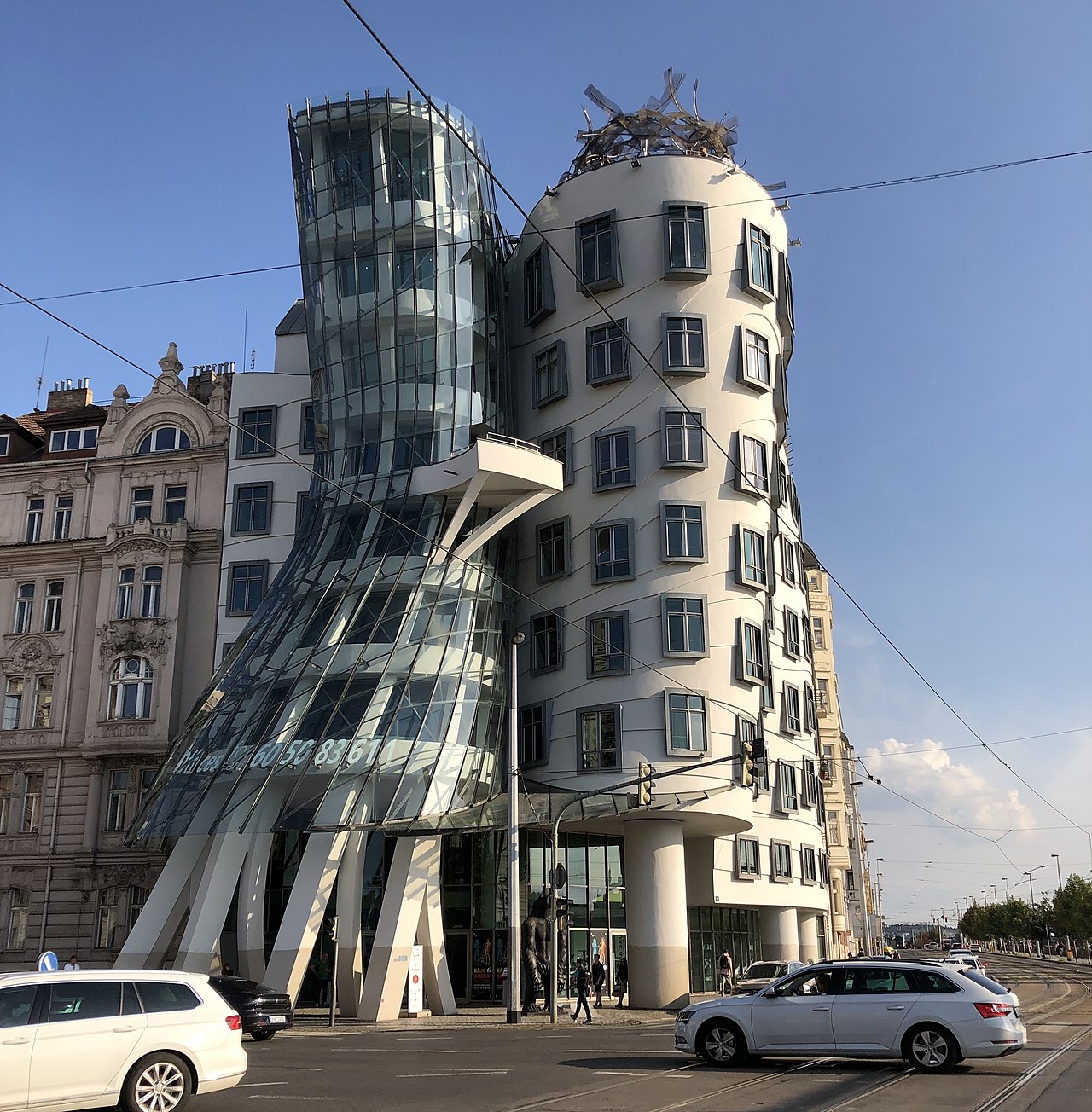What Is The Dancing House In Prague?
The Dancing House Prague, also known as Fred and Ginger, is an iconic building in Prague, Czech Republic. It was designed by architects Vlado Milunić and Frank Gehry. Finished in 1996, it stands out for its unconventional, de-constructivist design enlivened by dancers Fred Astaire and Ginger Rogers.
The building further features two pinnacles that appear to dance together, with one looking like a woman and the other a man. It houses a hotel, restaurant, and offices. Because of this, it’s a popular tourist attraction. It’s also notable for its special architecture and panoramic perspectives on Prague.
Bridging the Past and Future
The Dancing House in Prague spans the past and future through its architectural design and its place in the historic cityscape:
- Architectural Contrast: The Dancing House’s unconventional design stands in stark contrast to the traditional and historic architecture that encompasses it in Prague’s city place. This architectural contrast symbolizes a scaffold between the city’s rich past and its developing future.
- Postmodern Innovation: The building’s de-constructivist and postmodern architectural style addresses a departure from traditional design standards, signaling a break from the past and a stage toward a more innovative and forward-looking architectural approach.
- Cultural Icon: As a contemporary landmark in a city saturated with history, the Dancing House has turned into a cultural icon that addresses Prague’s embrace of advancement while maintaining a profound association with its historical roots.
- Adaptive Use: The building’s adaptive use, lodging a hotel, restaurant, and offices, demonstrates how historical designs can be reused for current requirements, emphasizing the concurrence of the past and the future.
In these ways, the Dancing House serves as a symbol of Prague's ability to embrace its historical heritage while embracing innovation, subsequently bridging the past and future.
Frank Gehry’s Vision
Frank Gehry's vision for the Dancing House in Prague is a testament to his innovative approach to architecture:
- De-constructivist Icon: The Dancing House encapsulates Gehry’s obligation to de-constructivist architecture. The building’s unconventional and curvaceous design challenges traditional architectural norms, creating an iconic construction that stands out in Prague’s historic setting.
- Sculptural Elegance: Gehry’s vision for the Dancing House emphasizes its sculptural qualities. The building’s dynamic, almost whimsical appearance looks like a pair of dancers moving, transforming it into a living show-stopper inside the cityscape.
- Material Innovation: Gehry’s utilization of materials is obvious in the Dancing House’s design. The building’s outside features a combination of glass panels and concrete, showcasing Gehry’s readiness to explore different avenues regarding materials and surfaces to achieve his artistic vision.
- Contextual Sensitivity: While the Dancing House is avant-garde, Gehry’s vision guarantees it regards its environmental elements. The building supplements Prague’s historic architecture while offering a cutting edge and contrasting point of view.
- Functional Harmony: Gehry’s design doesn’t think twice about. The Dancing House houses a hotel, restaurant, and offices, demonstrating his obligation to creating spaces that are visually striking as well as fill practical needs.
- Human-Centric Experience: Gehry’s vision considers the human experience inside the Dancing House. The inside spaces are designed considering solace and usability, making it an inviting and engaging place for guests.
- Cultural Landmark: The Dancing House embodies Gehry’s knack for creating cultural landmarks. It has turned into an iconic symbol of Prague, adding to the city’s architectural and cultural personality.
In summary, Frank Gehry’s vision for the Dancing House in Prague encapsulates his innovative and artistic approach to architecture, creating a building that marries structure and capability while pushing the boundaries of traditional design. The Dancing House is a testament to his persevering through impact on contemporary architecture and its ability to turn into a celebrated cultural landmark.
From Controversy to Icon
The Dancing House in Prague went from controversy to icon through a combination of factors, including time, public perception, and its cultural and architectural significance:
- Initial Controversy: While the Dancing House was first developed during the 1990s, its avant-garde design and stark contrast with Prague’s historic architecture generated controversy. Many individuals questioned its place in the city and its tasteful appeal.
- Architectural Merit: Over the long run, as individuals began to understand the architectural innovation and artistic vision behind the Dancing House, it gained acknowledgment for its one of a kind design and commitment to contemporary architecture. Pundits and architectural enthusiasts started to appreciate its strength.
- Tourist Attraction: The Dancing House’s location in the heart of Prague and its unmistakable appearance began attracting tourists. Guests from around the world were drawn to the building, and it became a popular landmark to visit.
- Cultural Symbol: The Dancing House took on cultural significance as a symbol of Prague’s embrace of innovation while preserving its historical heritage. It came to address a city in transition, bridging its past with a dynamic future.
- Architectural Awards: The Dancing House got architectural awards and accolades for its design and commitment to the field. These awards cemented its reputation as an architectural icon.
- Adaptive Use: The building’s adaptive use, lodging a hotel, restaurant, and offices, demonstrated its practicality and versatility. It demonstrated the way that avant-garde architecture could also fill functional needs.
- Media Coverage: Broad media coverage, including documentaries and articles, advocated the Dancing House’s story, drawing much more attention to its architectural significance.
- Local Acceptance: As locals gradually accepted the Dancing House as part of their cityscape, it began to integrate more seamlessly into the urban fabric, further solidifying its status as an icon.
Time and Evolution: As years passed, what was once controversial became part of Prague’s cultural and architectural heritage. The Dancing House became a symbol of the city’s ability to develop while preserving its past.
Basically, the Dancing House went from controversy to icon by weathering initial wariness, gaining acknowledgment for its architectural merit, and ultimately turning into a cherished and celebrated landmark that addresses the crossing point of history and advancement in Prague.
What Makes The Dancing House An Architectural Marvel?
The Dancing House in Prague is celebrated as an architectural marvel because of its groundbreaking design and innovative features. It typifies de-constructivist standards with irregular shapes and liquid lines.
This sculptural masterpiece, suggestive of dancers moving, further challenges conventional architectural norms. It harmoniously integrates with Prague’s historic setting while at the same time symbolizing the city’s transition to a more dynamic future.
This marvel showcases that avant-garde architecture can also be functional. The Dancing House is a cultural landmark and a symbol of contemporary architectural greatness.
A Twist in Tradition
The Dancing House in Prague addresses “A Twist in Tradition” because of its innovative and unconventional architectural design. Because of this, it challenges traditional norms, presenting a dynamic and artistic departure from the city’s historic architecture.
Curves in Concrete
The Dancing House achieves “Curves in Concrete” by utilizing a special architectural design that shapes concrete into streaming and bended structures. Because of this, it challenges the traditional angular and unbending designs typically associated with this material.
This innovative utilization of concrete further adds to the building’s particular and artistic appearance.
Enjoy One-Of-A-Kind Panoramic Perspectives
Guests to the Dancing House can enjoy one-of-a-kind panoramic perspectives of Prague. The building’s strategic location along the Vltava Waterway offers breathtaking perspectives on the city’s historic horizon, including iconic landmarks like Prague Castle and Charles Scaffold.
Its highest levels give an extraordinary vantage highlight capturing the city’s beauty. Because of this, it’s a must-visit destination for those looking for unparalleled vistas of Prague’s enchanting view.
What Is The Dancing House Used For Today?
The Dancing House in Prague is used for a variety of purposes today, including:
- Hotel: It houses a hotel known as “Dancing House Hotel,” offering accommodation to guests who want to experience the exceptional atmosphere of the building and its panoramic perspectives on Prague.
- Restaurant: The Dancing House features a restaurant called “Ginger and Fred Restaurant,” named after the famous dancers Fred Astaire and Ginger Rogers. Visitors can feast in a polished setting while at the same time enjoying perspectives on the city.
- Offices: The building incorporates office spaces, accommodating various organizations and organizations. Its innovative design gives a particular workplace.
- Tourist Attraction: The Dancing House has turned into a significant tourist attraction in Prague, drawing guests from around the world who come to appreciate its architectural beauty and panoramic perspectives from its highest levels.
Basically, the Dancing House has been adapted for present day use, consolidating functionality with its iconic architectural design.
Art and Commerce Entwined
The Dancing House in Prague epitomizes the lacing of art and commerce. Its architectural design, a combination of innovation and artistic expression, serves as a testament to the power of creative vision.
Simultaneously, the building houses a hotel, restaurant, and offices, demonstrating how artistic ingenuity can be harmoniously integrated into commercial spaces, improving the human experience and giving practical utility while celebrating artistic achievement.
This dual capability of the Dancing House mirrors a cooperative energy among art and commerce, adding to its status as an iconic architectural marvel.
Preserving the Legacy of the Dancing House
Preserving the legacy of the Dancing House is paramount. Its iconic status as a cultural and architectural landmark in Prague highlights the importance of maintaining its special design. Further, it embodies its historical significance, and its job as a symbol of the city’s transition into a more dynamic future.
Relevant Search:









